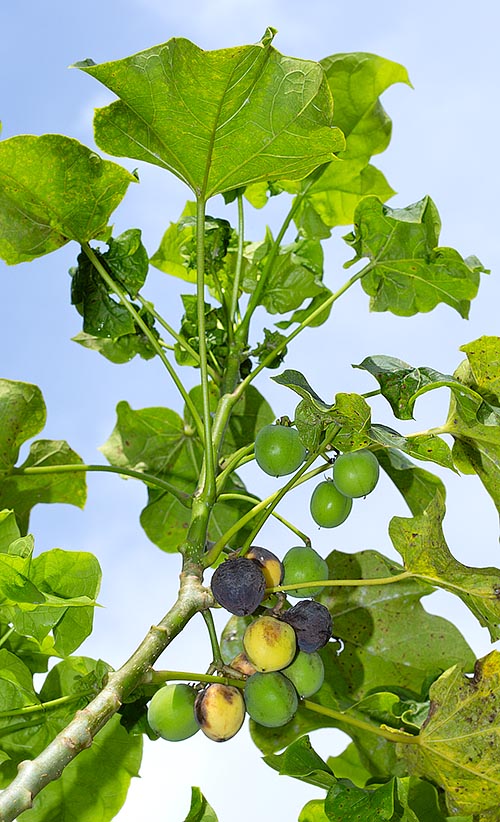This company has no active jobs
Pests Of Jatropha
Jatropha Curcas is getting value commercially as the need of fossil fuels increases tremendously and also Jatropha is an environment-friendly energy plantation. Plantation of this plant is considered to be an outstanding fuel replacement and it is likewise extremely affordable compared to other fuels. Recently, Jatropha is dealing with some trouble with pests and illness. The insects are classified into two varieties: Pest that impact young plants and Pest that affect matured plants.
Young plant bugs: Cutworm, Scarabeid Beetle, Army worm, Grasshopper.
Agrotis ipsilon: It is frequently referred to as Cut worm. This pest affects the seedlings and young Jatropha plants. If the plant is affected by the cutworm, the stem gets cut nearer to the soil surface and this will shrunk the plant totally.
Control: This pest can be controlled by selecting the larva discovered around the plants or by mixing the bran, sawdust with insecticides.
Scarabaeid Beetle: This pest ruins the root of the young plant. Initially, the larva takes in the natural matters present in the soil and then pertains to the root. The larva attack might eliminate the entire plant.
Control: The plant with good resistance power can get rid of the insect. For heavy attack, insecticides with components carbosulfan and carbofuran can be utilized to kill the insect.
Army worm: Spodoptera litura existence can be determined by biting in the leaves. The severe infection might entirely eliminate the plants.
Control: Insecticides are used to control the insects.
Grasshopper: This prevails bug found in numerous plants. Valanga nigricornis and Locusta migratoria commonly attacks the plant. The pest often attacks the young plant.
Control: The insecticides used betacyfluthrin, cypermethrin, thiodicarb, MIPC, and fipronil.
Pest observed in fully grown plants:
Pest of Stem: Ostrinia furnacalis, Xyleborus spp.
Ostrinia furnacalis and Xyleborus: This bug harms the Jatropha stem and it is commonly seen in Indonesia. The stem attacked by this pest normally fall down. The presence can be recognized by the larva penetration hole at the stem.
Control: The Insecticide normally used to control this pest is carbofuran.
Pest of leaf: The common insects observed are leaf caterpillar, Neetle caterpillar, Leaf hopper, Mite, Ear corn caterpillar.
Leaf Caterpillar: This bug can consume all the leaves of the plant simply put duration. The quality and yield of the seeds get lowered due to the heavy attack.
Control: This can be controlled by selecting the old larvae around the surface area and throwing away the attacked leaves.
Needle Caterpillar: This caterpillar is covered with spines and produces a burning sensation when enabled to call with skin as it produces certain chemical substance. Initially the insect crowded in the leaf and after that spread all over the plant when it ages.
Control: Manually, the pest can be killed only by soaking it in water or kerosene. The heavy attack can be managed by spraying organophosphate insecticides.
Leaf Hopper: This insect is discovered mostly in tropical and subtropical areas. The bug targets the leaf and sucks all the nutrients of the leaf and gets curls at the pointer. Later, the entire leaf dry and pass away.
Control: The heavy attack can be by utilizing insecticides like imidachloprid, beta cyfluthrin or carbosulfan.
Mite: Mite also assaults the leaf and makes the whole plant weak. The pest existence can be determined when the leaf become yellowish, shrinks, turns red and fall down. The bug can likewise be spread out through fallen leaves.
Control: Some preventive measures can be simulated appropriate sanitation and burning the fallen leaves. Heavy attack can be dealt with by spraying insecticides.
Some awful bug which assaults flower and fruit are, Stink bug (Nezara viridula)
Chrysocoris javanus, Tip borer caterpillar.
Stink Bug: Sting bug is a major pest which attacks the plant throughout bloom period so the crop yield completely drops. This insect is seen around the tropical area.
The harmful enzyme in the plant shrinks the whole plant.
Control: Insecticides suggested for this pest is chlorfluazuron, diflubenzuron, alfamethrin, and lamda cyhalothrin.

Tip borer caterpillar: The pests commonly occurs attacks the plant in flowering season and this pest is seen commonly in tropical areas. The female insect laid the eggs on the tender part of the plant and the young larvae feed the young fruits and plant tips.
Control: Manually, the attacked seeds are suggested to burn. The insecticides like monocrotophos and bensultap are sprayed at the blooming season.


